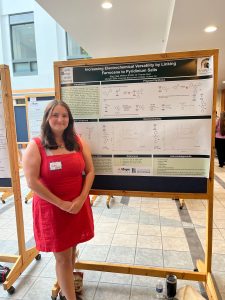Increasing Electrochemical Versatility by Linking Ferrocene to Pyridinium Salts
Riley Clark, Madison Shaffer, Thomas Guarr
Flow batteries have become increasingly popular due to their increased lifespan and ethical sourcing of raw materials. While aqueous flow batteries have been studied for decades, nonaqueous organic flow batteries are generating new interest because of their higher cell voltages, greater structural diversity, and low manufacturing costs. This work focuses on linking ferrocene catholytes to pyridinium anolytes to produce molecular systems that can be both reduced and oxidized. By using this approach, the expensive ion-selective membrane normally used in flow batteries can be replaced with a simple, inexpensive porous separator. Numerous synthetic pathways to such compounds have been explored, however the most promising of these involves the synthesis of substituted nitrophenyl ferrocenes via Suzuki coupling, followed by the reduction to produce an amine, and finally condensing the ferrocenyl amines with a pyrilium salt. Further work involves testing the electrochemical properties, solubility, and stability of these compounds.
Riley is our first highlighted intern and she comes to us from Clemson University. One of her mentors there was a former intern of ours and she came to us highly recommended. Riley did some great synthesis work and her accomplishments are even more amazing when you consider she has only completed one year of undergrad! We appreciate that she spent her summer with us when most people her age are working summers part-time scooping ice cream or something. You are a very impressive person, Riley! When the winter gets too long up here, we are going to take a field trip to South Carolina to visit.


